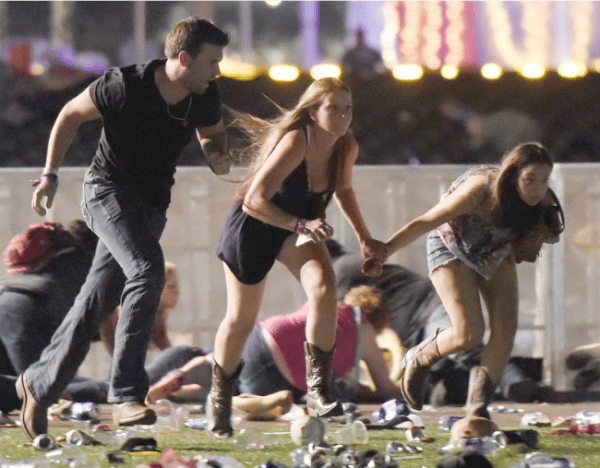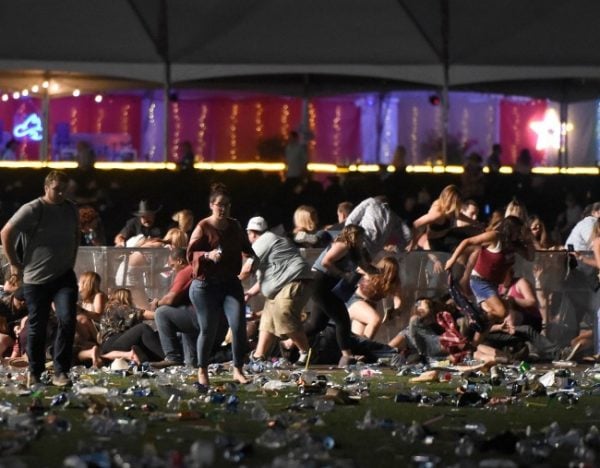At 10:08pm on Sunday night, a ‘lone wolf’ gunman named Stephen Paddock opened fire on crowds below from the 32nd-floor of the Mandalay Bay Resort and Casino in Las Vegas.
The 64-year-old, who had no prior criminal record, took aim at the Las Vegas village concert venue with a crowd of 22,000 people, approximately 400 metres away.
Armed with 20 weapons, including automatic and semi-automatic rifles, Paddock fired at concert-goers in a spree that is reported to have lasted between five and 15 minutes.
Paddock, a white male, killed at least 59 people and injured an estimated 527.
Listen: Journalist Amelia Lester and Mia Freedman gather to discuss the largest mass shooting in US history, and gun laws that desperately need to change. Post continues after audio.
It has now been declared the deadliest shooting in modern US history.
In the United States, shootings have become part of the fabric of everyday life. Las Vegas was the 273rd mass shooting of the year.
If you are ever caught in a shooting, here’s what experts say you should do.
“Running, if you have a clear exit, is the best choice,” says SEPTA Chief of Police Thomas Nestel, who has had more than 35 years experience in law enforcement.
“Try to get other people to flee with you, if they will do so immediately. If you can see a shooter, he can see you, so try to crouch and run as fast as you can so that you are not an easy target. Keep running until you reach a place of safety. Then call emergency services. If you are wounded, keep running as long as you can.”



Top Comments
The news sickened me. I'm not sure how to start this post, and I've been procrastinating about posting for hours now. The events were terrible, the lives lost were tragic and ..... well, I can't say anymore, everyone knows the story now
But I cannot agree with fear-mongering article like this, it is not an everyday occurrence where people apparently now have to learn how to avoid a sniper on the 34th floor attending a concert. So why the advice for something that is never likely to happen.
I know this will not be published, but you are pouring kerosene on the fires of hysteria and I cannot see that helping anyone.
"The news sickened me" says good things about you as a person, Random Dude.
Agree RD, it's general advice anyway whereas your choices depend on the situation. For a sniper all you need do is obtain cover or at least concealment and wait it out. But, say it's multiple shooters going through a mall, the last thing you want to do is stay put as they do their sweep. In that scenario, forget the entrances because that's what they would attempt to cover, you'd head towards the loading docks as they are much bigger and so much harder for bad guys to seal off and that will be the first place responders will enter and secure when they start to arrive.
It is generally better to wait for the gunmans mag to get very low, if you feel you can pick that, or wait for them to reload, but remember soldiers are trained with the knowledge that it's always faster to pull your sidearm than to change a magazine. Either way you won't have much time and when you hear the bolt click that's definitely time to throw yourself behind cover because as he reloads he will have a chance to survey the scene and pick his next targets.
Also, not sure about running with a group, soldiers are trained to do the exact opposite under fire, you spread out, not congregate as a group of people together becomes a much better target. Again, it's all situation dependant.
Awesome information for anyone who finds themselves in such a terrifying situation. I work for emergency services in Aust and I am unaware of any system that allows police or paramedics to respond to your CURRENT location if you are unable to speak. Typically the CLI details are used, the address the phone is registered to, which is useless in this context.